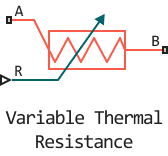Variable Thermal Resistance
Variable thermal resistance.
blockType: AcausalFoundation.Thermal.Elements.VariableResistance
|
Path in the library: |
Description
The Variable Thermal Resistance block allows the time-varying heat transfer process to be modelled in generalised terms, whether by conduction, convection, radiation or a combination of these. Thermal resistance is an abstract quantity that combines conduction, convection and thermal radiation. The thermal resistance of this block varies according to the input scalar signal on the R port.
The heat transfer equation for the thermal resistance block:
Where:
-
- thermal resistance.
-
- heat flux.
-
- temperature difference between layers.
Thermal resistance is related to other heat transfer values as follows:
Where:
-
- is the distance between the layers, i.e. the thickness of the material.
-
- is the area of the cross-section perpendicular to the direction of heat flow.
-
- thermal conductivity of the material.
-
- convective heat transfer coefficient.
-
- radiation coefficient.
-
and - temperatures at ports A and B respectively.
Parameters
Minimum thermal resistance - minimum allowable thermal resistance value
`0 K/W (by default)
If the input scalar signal drops below this value, the resistance remains at this value.
Initial value of temperature difference - initial value of temperature difference
0.0 K (by default).
Initial value of temperature difference.
Initial value of heat flow rate - initial value of heat flow rate
0.0 W/(K*m²) (by default).
Initial value of heat flow rate.
